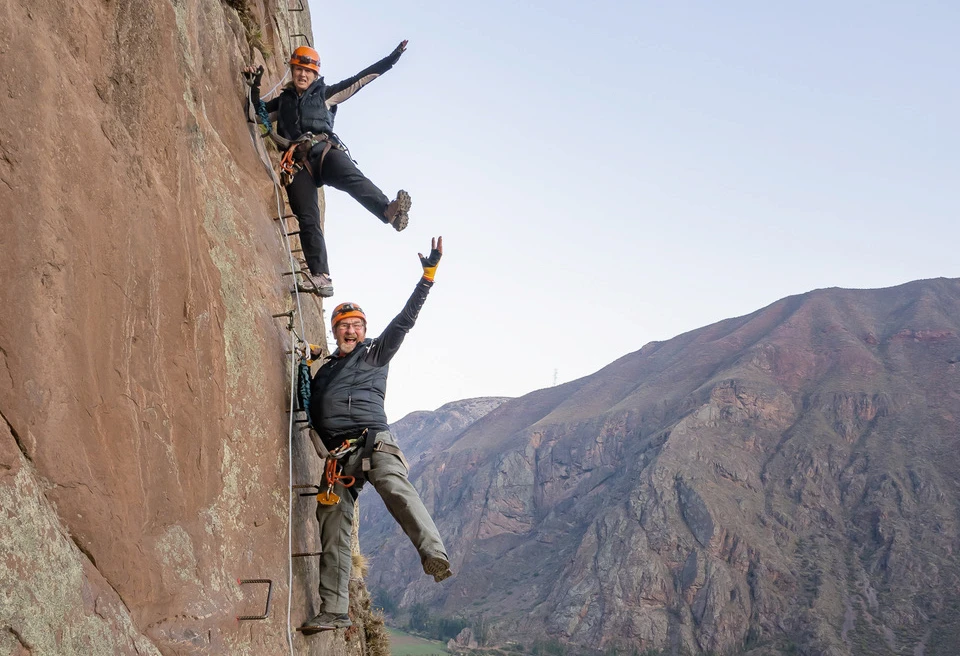When Mark Gallagher first saw images of glass accommodation pods attached 400m up a sheer cliff face in Peru, he knew he had to try it.
The Skylodge Adventure Suites in Peru opened in June 2013 — the world’s first hanging lodge. Featuring transparent, glass-enclosed capsules suspended from a mountainside, guests must climb a via ferrata or the long zipline trail to reach their rooms.
“My partner Bronwyn was terrified for four years,” he says of the wait they had to endure after initially booking in 2019 for a 2020 departure (the wait list was over a year) and then Covid delaying the trip for another three years.
“It took us 45 minutes,” Mark says of the climb, which consists mostly of bits of steel like large staples, hammered into the cliff-face, interspersed with walking ropes — two to hold onto and one to walk along.
“There was no major health and safety briefing … we were just given a harness, told to ensure we were attached by at least one of the two carabiners at all times, and then we were off.”
The couple trained by climbing Paritutu and large towers at Methanex, where they both work, in the weeks before their departure.
There are only three pods, each accommodating two people, with a fourth pod utilised as a dining place and communal area.
“All we had to take was a toothbrush,” says Mark, though he also took his camera, which he immediately set to good use. Bronwyn surprised them both by tackling the climb with gusto and thoroughly enjoying it. Not every guest does … the company has had guests that arrive at the site, look at what they have to do and go “No way”.
“That evening we were fed a four course dinner in the dining pod with the other two couples (from Japan and the US)— it was amazing!”
They then had to traverse across ropes to their sleeping pod — after consuming ‘a very nice red’ with dinner.
He and Bronwyn both slept well awaking to the early daylight and the stunning view of the Sacred Valley beneath them.
“There was no feeling of not feeling safe or anything like that at all.
“Then we got to zipline down, which was great fun!”
Though that experience was the highlight of the couple’s holiday to Peru, and the catalyst for the trip, there’s no point in flying all the way there for literally just one night.
“We were away for four weeks in total and every day had something incredible to offer.”
They flew direct to Houston (where it was 40C!) then to Lima for two nights.
Their next flight was over the Andes to the Amazon jungle where they stayed in a conservation lodge. On one of the feeder rivers to the Amazon they boarded a long narrow boat and were taken by their guide to various walking tracks and sites down the river.
Wildlife ranged from colourful birds like flamingoes, macaws and toucans to a bright yellow frog no bigger than an adult thumbnail. There were all sorts of monkeys and other primates plus reptiles like caymans, and clouds of various butterflies that would just surround them.
Next came probably the scariest time of the whole trip — the bus ride to the Machu Picchu site up a narrow winding road with sheer drops should the driver get things wrong.
“We had a guide just for us for a whole day at Machu Picchu, which was great, then we had another day on our own to explore the site and other archaeological treasures in the area.”
They then boarded the Andean Explorer train, which is like the South American equivalent of the Orient Express.
“We had our own sleeper car, cocktail lounge, dining car, music, it was all very old English luxury.”
Stops including Lake Titicaca and the Uros floating reed islands.
“We got on a boat and headed out to these floating islands to see the families that live there and their homes. You get to walk on one of the islands — the surface is sort of springy and constantly moving around beneath you. That was really interesting.”
The train ride continued and all the time they’re looking at wildlife like alpacas, limas, llamas, and more.
Their penultimate stop was Mirador Cruz del Cóndor viewpoint — a popular spot for observing the Andean Condors. The Colca Canyon boasts a population of over 100 condors, and the early morning thermals in this deep canyon allow the condors to take flight.
“The accommodation that last night was absolutely beautiful,” says Mark.
Their final night was the town of Arequipa, known as ‘the white city’ — “it was truly beautiful.”
He also comments about the guides: “they were so friendly and accommodating — they made it so easy for us, effortless.”
Also the markets, the incredible cathedrals — especially in Lima — and the food. Guinea pigs (or cavey, aka cuy) are the national dish of Peru and taste like a really moist roast pork with crackling and everything, reckons Mark.
The whole trip was organised by Lisa Sutton, who is now at World Travellers.
“She does the best job for us all the time.” He and Bronwyn have been on a big trip most years for the past 20 years. “She finds the best little boutique hotels and places that have those special things that may cost a little more, but make your experience that much greater.”
CAPTIONS:
DJI_0261 — Each accommodation pod has a double bed at one end, a lounge area with tea and coffee making facilities in the central area, and a bathroom and toilet at the other end. Entry and exit is through a hatch at the top of the pod.
DSC_5732 —Capybara are like guinea pigs, but the size of sheep.
